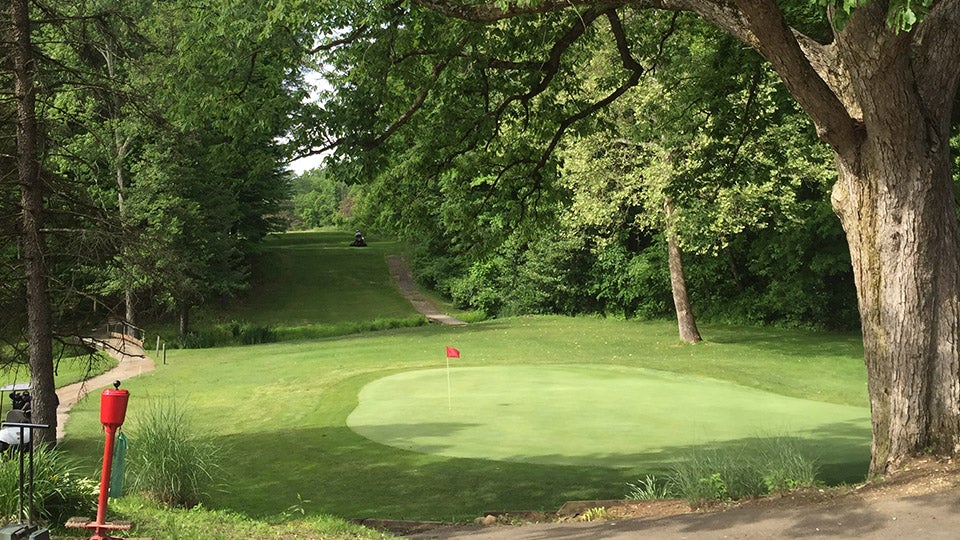COLUMBUS, Ohio—The Minerva Lake Golf Club was born here in 1931. It will die here in 2016.
Its last day of operation will be the Fourth of July. The middle of summer — and the golf season! — seems like a strange time to shut down a popular local public golf course, but as one observer noted of the sellers, “They didn’t do a very good job of negotiating.”
I’m sure the Minerva Lake regulars have felt like calling the Crimestopper hotline for months since the news came out that, after more than a decade of assorted rumors, this will finally be the old course’s last gasp.
Golf feels real at Minerva Lake. You can walk a quick 18, rent a rusty pull cart or drive a real cart. Ralph in the pro shop will book your tee time, sell you a ball maker for 25 cents or take your cash for a limited edition T-shirt from the pile on a nearby shelf. It has the course logo outlined in red and it’s stamped, “Est. 1931-2016.” It’s the first golf course logo I’ve ever seen with an expiration date.
This place is only 16 miles from the swank Muirfield Village Golf Club, where I’m covering the Memorial Tournament this week, but it couldn’t feel farther away. At Muirfield Village, there is glitz and Lexus courtesy cars and money and no blade of grass out of place, just the way founder Jack Nicklaus wants it. It’s almost too good.
Minerva Lake is imperfect, although it is in terrific shape, and isn’t tough. It’s barely 5,700 yards from the blue tees. The two par 5s on the front nine, the only par 5s on the par-69 course, are less than 450 yards.
But Minerva Lake is no pushover. It’s the kind of quaint throwback that helped golf gain popularity in the 20th century—it’s quick and fun, the rough is short, there isn’t a lot of trouble and, by the way, there are no sand bunkers. Nobody seems to miss them, either.
Our media threesome had a pre-7 a.m. tee time and buzzed around just under three hours, ahead of what seemed like an endless line of golfers behind us. Our group included my Sports Illustrated colleague John Garrity and blogger extraordinaire Stephanie Wei. We played briskly, because this course affords that.
The reason Minerva Lake will go the way of Oldsmobile, Forbes Field and the dodo bird is money, of course. This deal is mostly about real estate. This tree-lined sanctuary is too valuable to remain a low-cash-flow golf property. Only an owner committed to golf could keep it going, and the current owners are descendants of the course’s original founders. Ralph in the shop says the descendants own several area courses and two of the kids run the other courses, but none of them want to operate this one. They’d rather have the money. A developer accommodated them. Golf out, houses in.
Golf is in a serious state. A few hundred courses close every year, equipment giant TaylorMade is for sale, and fewer golfers are playing fewer rounds on fewer courses. Acknowledging that might be bad for business so no one, including the media, likes to go there.
That said, no one who loves the game would give this course up after playing it once.
(RELATED: The Death of a Golf Course — The Withering Stevinson Ranch)
When I mentioned to a couple of Columbus sportswriters at the Memorial that I was going to play Minerva Lake, they pooh-poohed the course somewhat dismissively. I can only conclude that it stemmed from the course’s lack of length and par of 69.
The truth is, the place is a delight and the course’s original holes are dazzlingly fun, especially the par 3s. Harold Pollock built the track next to a turn-of-the-century amusement park, casino and railway station. The course’s remaining original greens have shades of C.B. Macdonald and A.W. Tillinghast. Some have been replaced by flat, ordinary putting surfaces that were jury-rigged years ago as development chipped away at the original property’s boundaries.
The par-3 fourth is the first hole we played that felt like it escaped from the Yale Golf Club in Connecticut, a Macdonald special. It’s a 155-yard par 3 to a green on a plateau and it’s all carry. Come up short and your ball is careening down a slope. It’s a hero shot, a theme that is often repeated.
The 10th is 359 yards but the average hack doesn’t dare hit driver. I laid up with a five-iron toward the end of the fairway, which is perched on a terrace above a stream and a second fairway. From there, I hit another five-iron to the distant green—it would be an award-winning par 3 from the landing area if it wasn’t already a par 4.
The 18th is a veritable chip shot, a mere 128 yards from an elevated tee through a narrow chute of trees to a green below, perched in front of the clubhouse. A million years ago, there was a dance pavilion where the woods are now. It’s a scenic shot and maybe a signature hole.
We pressured each other to make a birdie on this last green, presumably the last chance any of us would ever have to make a birdie at Minerva Lake. History was at stake. Stephanie’s chip from just off the fringe was on line but came up just short. John’s putt from the fringe also ran out of gas. My 15-footer from above the hole started right, stayed right and never had a chance. “Another stupid caddie misread,” I noted unhappily. We didn’t have caddies.
Then came the obligatory handshakes and glad tidings and that special feeling of time well-spent even if it wasn’t a round well-played.
We stopped by the shop to say farewell to Ralph and express our thanks for the memorable morning. “I almost wish I hadn’t played here today,” said Garrity, a Kansas City resident, “because now I’m going to miss it.”
You don’t need a million-dollar golf course to make you feel like a million bucks. Minerva Lake is proof. For one more month, you can still experience the feeling. By the time you see Fourth of July fireworks, though, another piece of golf history will have quietly vanished forever.







